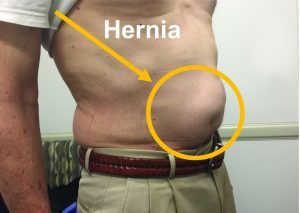By Adam P. Lipkin, MD, Fellow American College of Surgeons


A hernia is defined as a defect (hole) in the tough layer of muscle (called fascia) that allows tissue to protrude where it does not belong. A ventral hernia specifically occurs in the abdominal wall, between the groin and the rib cage.
The most common ventral hernia occurs at the umbilicus. The umbilicus, aka navel or belly button, is a natural weak point of the abdominal wall. As a baby, your umbilical cord had blood vessels coming from your mother’s placenta and passed through the abdominal wall where your umbilicus is now. The small defect in the abdominal wall typically closes but many babies (15%) are born with an umbilical hernia and many adults form one over time. Fun trivia: the only hernia that will ever resolve on its own is an umbilical hernia in a baby. Most will resolve by age 4 or so. After that, surgical repair is required.
Another naturally occurring hernia is in the upper midline of the abdomen and is called an epigastric hernia. Like umbilical hernias, these are typically small but can get large over time. They are found below the sternum (breastbone) and above the navel.
Another category of ventral hernia is the incisional hernia. When someone has an operation in the abdomen, they are susceptible to forming a hernia at the site of their incision. After all, to gain access to the abdominal cavity, muscle of the abdominal wall has to be cut. It is sutured closed but will never heal to its original strength. Obesity, coughing, smoking, poor nutrition, and compromised health all contribute to suboptimal healing and a higher risk of hernia formation.
So how do you recognize a ventral hernia? Look for a lump just under the skin that comes and goes. A ventral hernia can be as small as a marble or as large as a basketball. It will be more pronounced when standing up and especially so with coughing or straining. It should get smaller and more comfortable when laying flat on your back. You may feel it pop or squish in and out. It will be located near the navel or a previous surgical scar. It may be painful or just uncomfortable. Usually it is worse at the end of the day after being on your feet and active for a while.
Without an operation to repair a hernia, it will typically get larger, more uncomfortable, more limiting of activity, and harder to repair. There is also risk of incarceration which is an emergency involving tissue trapped in the hernia. For these reasons, a ventral hernia should get evaluated by a general surgeon, someone who specializes in operations of the abdomen.
The good news is that ventral hernias can be repaired as an outpatient. Typically the repair is minimally invasive, using very small incisions to look inside the abdomen and repair the hernia from underneath so it is unlikely to cause further problems. Recovery and return to activity is in a matter of days. Surgery isn’t nearly as painful or debilitating as it once was so don’t ignore a hernia. If you think you may a hernia, see your provider or give my office a call.
Dr. Adam P. Lipkin has been practicing General Surgery in Southwest Florida since 2001. Dr. Lipkin specializes in minimally invasive surgery and has the advantage of modern, up to date training coupled with 2 decades of Operating Room and Endoscopy experience. Dr. Lipkin is Board Certified in General Surgery, and is a member of the American College of Surgeons.
941.475.5431
www.dradamplipkin.com
779 Medical Dr., Suite 1
Englewood, FL 34223
 Southwest Florida's Health and Wellness Magazine Health and Wellness Articles
Southwest Florida's Health and Wellness Magazine Health and Wellness Articles

